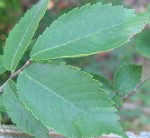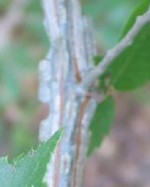 Winged elm is a small to medium sized deciduous tree native to the Southeast from Maryland to Kansas and south to Florida and Texas where it gros in open woods, floodplains, rocky slopes, and dry uplands. It is a member of the elm family, Ulmaceae that also includes Zelkova. The common name comes from the appearance of the branchlets that have a broad pair of corky wings about ½ inch wide. The dark green leaves are about 2.5 inches long, narrowly ovate, and have sharply doubly toothed margins and asymmetrical bases. The small insignificant flowers are brownish-green and appear in clusters from late winter to early spring before the leaves emerge. The reddish pappery fruit (samara)is winged , and contains a single seed. Winged elm is tolerant of urban conditions and can be used as a shade tree along sidewalks, in parking lots, and in highway median strips. It’s susceptibility, however, to disease limits its use. The generic name Ulmus is the Latin name for the tree. The specific epithet alata comes from the Latin word alatus meaning winged.
Winged elm is a small to medium sized deciduous tree native to the Southeast from Maryland to Kansas and south to Florida and Texas where it gros in open woods, floodplains, rocky slopes, and dry uplands. It is a member of the elm family, Ulmaceae that also includes Zelkova. The common name comes from the appearance of the branchlets that have a broad pair of corky wings about ½ inch wide. The dark green leaves are about 2.5 inches long, narrowly ovate, and have sharply doubly toothed margins and asymmetrical bases. The small insignificant flowers are brownish-green and appear in clusters from late winter to early spring before the leaves emerge. The reddish pappery fruit (samara)is winged , and contains a single seed. Winged elm is tolerant of urban conditions and can be used as a shade tree along sidewalks, in parking lots, and in highway median strips. It’s susceptibility, however, to disease limits its use. The generic name Ulmus is the Latin name for the tree. The specific epithet alata comes from the Latin word alatus meaning winged.
 Type: Deciduous tree
Type: Deciduous tree
Outstanding Feature: Urban tolerance
Form: Open rounded canopy
Growth Rate: Rapid
Bloom: Small insignificant brownish green flowers in clusters from late winter to early spring before the leaves emerge
Size: 30-80’ H x 25-40’ W
Light: Full sun to light shade
Soil: Average, medium moist, well-dained
Hardiness: Zones 6-9
Care: Prune to eliminate multiple stems and develop strong structure
Pests and Diseases: Dutch elm disease, elm yellows, powdery mildew, wetwood, wilts, rots, cankers, leaf spot, borers, lef miner, beetles, mealy bugs, caterpillars, and scale
Propagation: Seed, cuttings